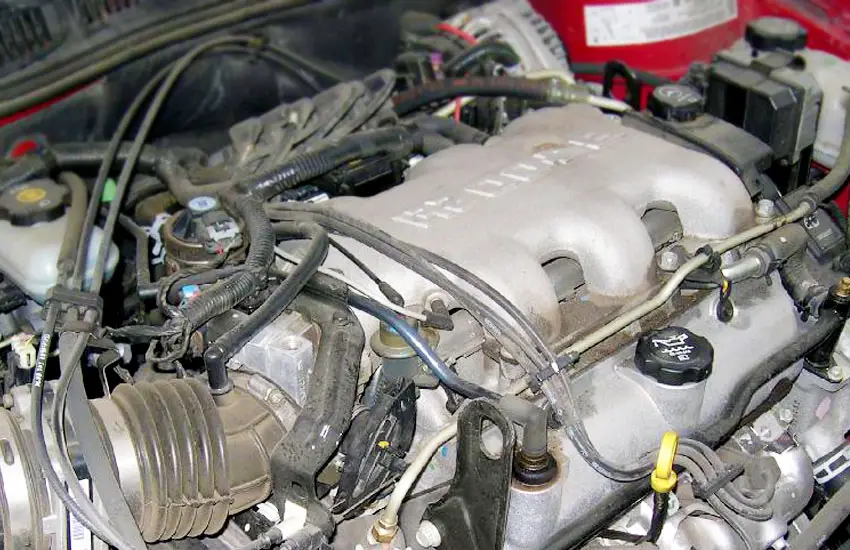As an Amazon Associate, I earn from qualifying purchases at no extra cost to you.
Common Issues With GM 3.4L V6 Engine: Troubleshooting Guide
You’ve probably heard about problems with GM’s 3.4L V6 engine. It’s important to understand what issues can happen and how to deal with them.
This engine, used in various GM cars like the Pontiac Grand Am and Chevrolet Impala, can have trouble with intake manifold gaskets leaking coolant.
This leads to overheating and potential engine damage if not fixed. Another common issue is with the lower intake manifold gasket failing, causing coolant leaks and engine problems.
Sometimes, the head gaskets can fail too, leading to similar issues. Knowing these common problems helps you stay informed and proactive about maintenance.
In this article, we’ll dive deeper into these issues and how to address them to keep your GM 3.4L V6 running smoothly.

Common Problems
When it comes to the GM 3.4L V6 engine, there are a few common issues that owners may encounter. These problems can range from minor annoyances to major concerns, and it’s important to be aware of them to ensure proper maintenance and avoid any potential damage.
Head Gasket Failure
Head gasket failure is a common problem in the GM 3.4L V6 engine. This gasket is responsible for sealing the cylinder head to the engine block, and when it fails, it can lead to several issues.
Coolant and oil can mix together, causing a milky residue on the inside of the engine. This can lead to overheating, loss of power, and potential damage to other engine components.
If you notice any signs of head gasket failure, such as white smoke from the exhaust, a sweet smell in the cabin, or coolant leaks, it’s essential to address the issue promptly.
Intake Manifold Gasket Issues
An intake manifold gasket is another problematic area in the GM 3.4L V6 engine. This gasket is responsible for sealing the intake manifold to the engine block, ensuring proper airflow and fuel delivery.
Over time, the gasket can deteriorate due to heat and age, resulting in vacuum leaks and causing issues with engine performance. Symptoms of intake manifold gasket issues may include rough idling, poor acceleration, and even engine misfires.
If these problems arise, it’s crucial to have the gasket replaced or repaired to avoid further complications.
Coolant Leaks
Coolant leaks are also common in the GM 3.4L V6 engine. These leaks can occur due to various reasons, such as a failing water pump, faulty radiator, or deteriorated hoses.
It’s important to address coolant leaks promptly as they can lead to engine overheating, potential damage, and even engine failure.
Keep an eye out for any signs of coolant leaks, such as puddles under your vehicle, coolant smell, or an erratic coolant temperature gauge.
If you notice any of these symptoms, it’s crucial to have the issue diagnosed and repaired to prevent further damage.
Overall, it’s important to be aware of these common problems with the GM 3.4L V6 engine. Regular maintenance and addressing any issues promptly can help ensure the longevity and optimal performance of your engine.
Symptoms
The GM 3.4L V6 engine may show several symptoms when facing issues. Here are some common signs that indicate potential problems with this engine:
Overheating
An overheating engine is a critical issue with the GM 3.4L V6. Leaking coolant, faulty thermostat, or a malfunctioning water pump can lead to overheating. Keep an eye on the temperature gauge for abnormal readings and inspect for any visible coolant leaks under the vehicle.
White Smoke From Exhaust
White smoke from the exhaust can be a sign of coolant entering the combustion chamber. This may result from a blown head gasket or a cracked cylinder head. Constantly monitor the exhaust for unusual emissions and check the coolant level regularly.
Engine Misfires
Engine misfires can occur due to faulty spark plugs, ignition coils, or fuel injectors. This leads to rough idling and poor acceleration. Diagnostic trouble codes (DTCs) can help pinpoint the source of the misfire, allowing for targeted repairs.
Diagnostic Steps
Check Coolant Levels
To begin diagnosing engine issues, check the coolant levels to ensure that the engine is adequately cooled. Low coolant levels can lead to engine overheating and eventual damage. Check the coolant reservoir and radiator for proper levels and inspect for any leaks or signs of contamination.
Compression Test
One crucial diagnostic step is to perform a compression test on the cylinders of the V6 engine. This test helps in identifying any compression discrepancies across the cylinders, which can indicate internal engine problems such as worn piston rings or valves. A compression test is vital for evaluating the overall health of the engine and identifying any potential issues.
Inspect Intake Manifold
Another integral diagnostic step involves inspecting the intake manifold for any signs of wear or damage. The intake manifold plays a crucial role in delivering air to the engine cylinders, and any leaks or damages can lead to poor engine performance.
Visually inspect the intake manifold and the associated gaskets for any cracks, leaks, or signs of gasket deterioration. Additionally, perform a smoke test to identify any leaks in the intake manifold system.
Preventive Measures
Routine Maintenance
Regular maintenance is crucial for keeping your GM 3.4L V6 engine in good condition. By following a routine maintenance schedule, you can catch any potential issues early and prevent major problems down the line. Some routine maintenance tasks to consider include:
- Regular oil changes every 3,000 to 5,000 miles to keep the engine properly lubricated.
- Checking and replacing air filters when they become dirty or clogged.
- Inspecting and replacing spark plugs as necessary to ensure optimal ignition.
- Monitoring and topping up fluid levels, including coolant, brake fluid, and transmission fluid.
- Inspecting belts and hoses for signs of wear and replacing them if necessary.
By staying on top of these routine maintenance tasks, you can greatly reduce the risk of engine issues and keep your GM 3.4L V6 running smoothly.
Use Quality Coolant
Coolant is essential for maintaining proper engine temperature and preventing overheating. Using a high-quality coolant specifically recommended for your GM 3.4L V6 engine is crucial.
Cheap or low-quality coolant may not provide the necessary protection, leading to engine damage and potential overheating issues. When choosing coolant, make sure it meets the specifications outlined by the manufacturer.
Regularly checking your coolant levels and topping them up as needed is also important. If you notice a significant drop in coolant levels or if the coolant appears dirty or discolored, it may be time to flush and replace the coolant.
Keeping your engine properly cooled with quality coolant will go a long way in preventing common issues with the GM 3.4L V6 engine.
Address Issues Promptly
When it comes to the GM 3.4L V6 engine, addressing any issues promptly is crucial in preventing further damage. Ignoring warning signs or delaying repairs can lead to more severe problems and potentially costly repairs.
Here are some issues commonly associated with the GM 3.4L V6 engine that should be addressed promptly:
- Overheating: If you notice your engine temperature gauge rising or steam coming from the engine compartment, stop driving immediately, and have the issue diagnosed and repaired.
- Knocking or ticking noises: Unusual engine noises can indicate internal problems. Have the engine inspected as soon as possible to avoid further damage.
- Loss of power or poor acceleration: If you experience a significant drop in engine performance, have it checked to identify and fix the underlying cause.
By promptly addressing any issues, you can prevent them from escalating into more significant problems that could potentially damage your GM 3.4L V6 engine.
Repair Options
When facing common issues with a GM 3.4L V6 engine, choosing the right repair option is crucial to get your vehicle back on the road.
Diy Repairs Vs. Professional Mechanics
- DIY Repairs: Simple fixes like changing oil or filters can be done at home with basic tools.
- Professional Mechanics: Complex issues such as internal engine problems require the expertise of a trained mechanic.
Cost Considerations
- DIY Repairs: Budget-friendly for minor repairs but may lead to additional costs if not done correctly.
- Professional Mechanics: Higher upfront cost but ensures proper diagnosis and long-term fix, saving money in the long run.
Conclusion
To sum up, addressing issues with the GM 3. 4L V6 engine is crucial for optimal performance. Regular maintenance, proper care, and prompt repairs can prevent major problems. By staying informed and proactive, owners can enjoy a smoother driving experience and extend the lifespan of their vehicles.





